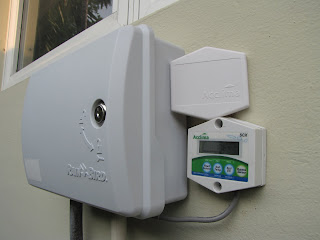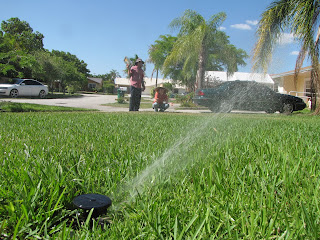
Re-installing
We began the day with the ambitious aim of visiting 5 properties in 7 hours: 2 new installations, one re-installation and 2 repairs.
First up was a property where the soil water sensor add-on device had quit reading moisture a week earlier. This add-on device consists of two components (controller and sensor) and is designed for pre-existing digital systems. The two components use existing wiring to communicate and prevent scheduled irrigation events when soil moisture is above the set threshold.

We replaced the sensor in the field (buried horizontally 3-4 inches under the turf) and protected wiring connections with grease caps and a junction box.


We then installed a new controller at the timer, initiated communication, and tested for irrigation prevention and bypass.

Since this site is part of the comparison study, one of the study zones always irrigates on schedule.
Our next stop was a property with a pre-existing digital system that elected to participate in the ET-based controller study. Because valves are already part of this system, our tasks were limited to:
- installing a water meter on the system's mainline for water-use data purposes



-replacing a decrepit anti-siphon valve (this device protects the potable water lines from irrigation system contamination) with a new one
- replacing the current timer with the “smart” controller that irrigates using self-generated ET information and irrigation zone specifics
- mounting the weather station in an area unobstructed from exposure to the elements

This 7 zone city water system with rotor and rotary zones and varying shade factors in its landscaping should provide great insights into ET-based controller water-savings potential.


…when you’re having fun









 In early March we assessed a property in North Miami Beach for a homeowner at wits end with his high water bills.
In early March we assessed a property in North Miami Beach for a homeowner at wits end with his high water bills. 

 A few weeks ago, we had the opportunity to revisit this property and see most all of our recommendations in action! Digital replaced mechanical, 6 zones were reduced to 4, spray heads had low volume nozzles added and the shrub zone is now watered only with a soaker hose!
A few weeks ago, we had the opportunity to revisit this property and see most all of our recommendations in action! Digital replaced mechanical, 6 zones were reduced to 4, spray heads had low volume nozzles added and the shrub zone is now watered only with a soaker hose!



